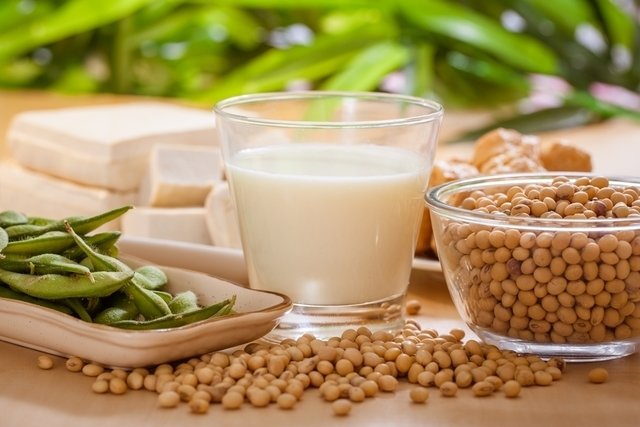Soy milk should only be offered as food to the baby if the pediatrician recommends it, as happens in cases where the baby cannot be breastfed, or when he develops an allergy to cow’s milk or even in some cases of lactose intolerance.
Soy milk in the form of infant formula is produced from soy protein and various nutrients that are essential for the baby’s growth. On the other hand, conventional soy milk, also known as soy drink, is poor in calcium and has less protein than cow’s milk, and is only recommended for children over 2 years of age and only in accordance with pediatrician advice.

Disadvantages and Dangers of Soy Milk
As it is in the growth and development phase, the consumption of soy milk by babies can lead to problems such as:
- Lower calcium content than cow’s milk, generally having calcium artificially added by industry;
- Calcium is difficult to absorb through the intestine, as soy milk contains phytates, a substance that reduces calcium absorption;
- Does not contain important nutrients such as vitamins A, D and B12, and you should look for formulas that have these vitamins added;
- Increased risk of developing allergiesas soy is an allergenic food and can cause allergies especially in babies who are already allergic to cow’s milk;
- Contains isoflavonessubstances that act like the estrogen hormone in the body, which can lead to effects such as precocious puberty in girls and changes in the development of breast tissue.
These problems can arise mainly because milk is the basis for feeding babies until the 6th month of life, which means they rely exclusively on soy milk and its limitations.
When to use soy milk
According to the American Academy of Pediatrics, soy milk should only be used for babies in cases of congenital galactosemia, which is when the baby cannot digest any cow’s milk product, or when the child’s parents are strictly vegan. and are not willing to offer cow’s milk to the child.
Additionally, soy milk can also be used for babies who are allergic to milk but not soy, which can be identified through allergy testing. See how the test is carried out to detect allergies.

What other milk can be used for the baby
When the baby has lactose intolerance, it is an easier problem to control and lactose-free infant formulas can be used, such as lactose-free Aptamil ProExpert, Enfamil O-Lac Premium or soy-based milks, according to the pediatrician’s advice.
But in cases where the baby is allergic to cow’s milk, it is usually avoided to use soy-based milk because soy can also cause allergies, making it necessary to use milk based on free amino acids or extensively hydrolyzed proteins, such as the case of Pregomin pepti and Neocate.
For children over 2 years old and allergic to cow’s milk, the pediatrician may recommend the use of soy milk or other vegetable drinks, but it is important to remember that they do not bring the same benefits as cow’s milk. Therefore, the baby’s diet must be varied and balanced, preferably guided by a nutritionist, so that he obtains all the nutrients necessary for his development. Find out how to choose the best milk for newborns.
Bibliography
- Soy Protein-based Formulas: Recommendations for Use in Infant Feeding. American Academy of Pediatrics. 101. 1; 148-153, 2008
- SANTA CRUZ Llerena; BUÑUEL JC. Some formula milks have an excessive concentration of aluminum. Evidence in Pediatrics. 6. 4; 1-4, 2010

Sign up for our newsletter and stay up to date with exclusive news
that can transform your routine!
Warning: Undefined array key "title" in /home/storelat/public_html/wp-content/plugins/link-whisper-premium/templates/frontend/related-posts.php on line 12
Warning: Undefined array key "title_tag" in /home/storelat/public_html/wp-content/plugins/link-whisper-premium/templates/frontend/related-posts.php on line 13




![4 passos simples para cuidar da pele oleosa [saúde]](https://storelatina.com/wp-content/uploads/2024/05/1716528980_4-simple-steps-that-work-305x207.jpg)